
To be completely honest, when I was in college, I did just enough work to get through the biology, physiology, and organic chemistry classes I took.
I memorized information so I could pass a test. Then got back to work studying everything I could find on strength training and improving body composition.
I didn’t see any connection whatsoever between things like the Krebs Cycle and how I should train.
If I could go back in a time machine and talk to myself then, I’d tell myself I was being an idiot.
What it took me many, many years of experience to understand is that the real answers to health and fitness aren’t found in the articles in muscle magazines, or even in most books on training.
Instead, they can be found deep within the pages of all the cellular biology and biochemistry textbooks I mostly ignored back then.
That’s because it’s only by truly understanding how our DNA interacts with our environment (which includes training) to drive us either towards health and performance or away from it, that we can unlock our body’s true potential.
I shared a bit about how this big picture all starts with metabolism and introduced the upcoming launch of Precision Metabolix in my last article (click here if you missed it). So today, I want to dive deeper.
I’m going to do my best to connect the dots between the science I mostly skipped over in my college textbooks and how I’ve helped some of the top athletes in the world get in the best shape of their lives—and, ultimately, what that means for your health and fitness.
How the origins of life as we know it are connected to how you should be training

Somewhere around 1.5-2 billion years ago, an ancient type of bacteria that could use oxygen to create energy was engulfed by a primitive single cell that couldn’t. Instead of being digested by the cell, the bacterium became a permanent resident and life as we know it became possible.
Over time, these bacteria evolved into what we now know as mitochondria. Today, your body is filled with about ten million billion of them. Collectively, they make up around 10% of your body weight.
Most cells have several hundred to thousands of them, with the cells in your heart having the highest number at roughly 5,000 mitochondria per cell.
Even more interesting, because mitochondria started as an independent type of bacterium, they have their own DNA, separate from what’s contained in the cell nucleus.
Mitochondria are absolutely essential to life, and for more reasons than most people know. They’re one of the biggest keys to everything from your health to your performance, and just about everything between.
That’s because even though most people think of mitochondria simply as the “powerhouses of the cell”, the truth is much more interesting.
Yes, the vast majority of energy you produce is generated in the mitochondria, but they do so much more than that.
In addition to being the primary site of ATP (the body’s energy currency) production, mitochondria also perform a wide range of vital functions throughout the body, including:
- Synthesis of steroid hormones like testosterone and estrogen
- Synthesis of glucocorticoids like cortisol
- Direct communication with the cell nucleus to regulate gene expression
- Regulation of inflammation processes and immune function
- Regulation of calcium signaling and muscular contractions
- Production of free radicals
- Activation of sirtuin enzymes that have been linked to longevity
- Cell growth and proliferation
- Cell death (aptoposis)
- Heat production
Why does one component of the cell drive so many essential functions for metabolism and life?
In a word: efficiency.
It’s highly efficient to connect energy production and the regulation of how energy gets used (energy expenditure) within the same component of the cell.
That’s what makes mitochondria such a key piece of metabolic performance, health, and longevity.
It’s not just a mindless energy production factory.
Instead, it’s constantly directing, coordinating, and working together with the cell nucleus to integrate all the information that’s coming in and then regulate how energy is expended throughout the body.
This puts mitochondria at the heart and center of managing the stress response and thus how your genetics interact with your environment to shape who you are.
This entire process, and all the different genetic pathways that play a role, are part of an unending effort to accomplish one very specific task: keep you alive by constantly adapting to the stress of your environment.
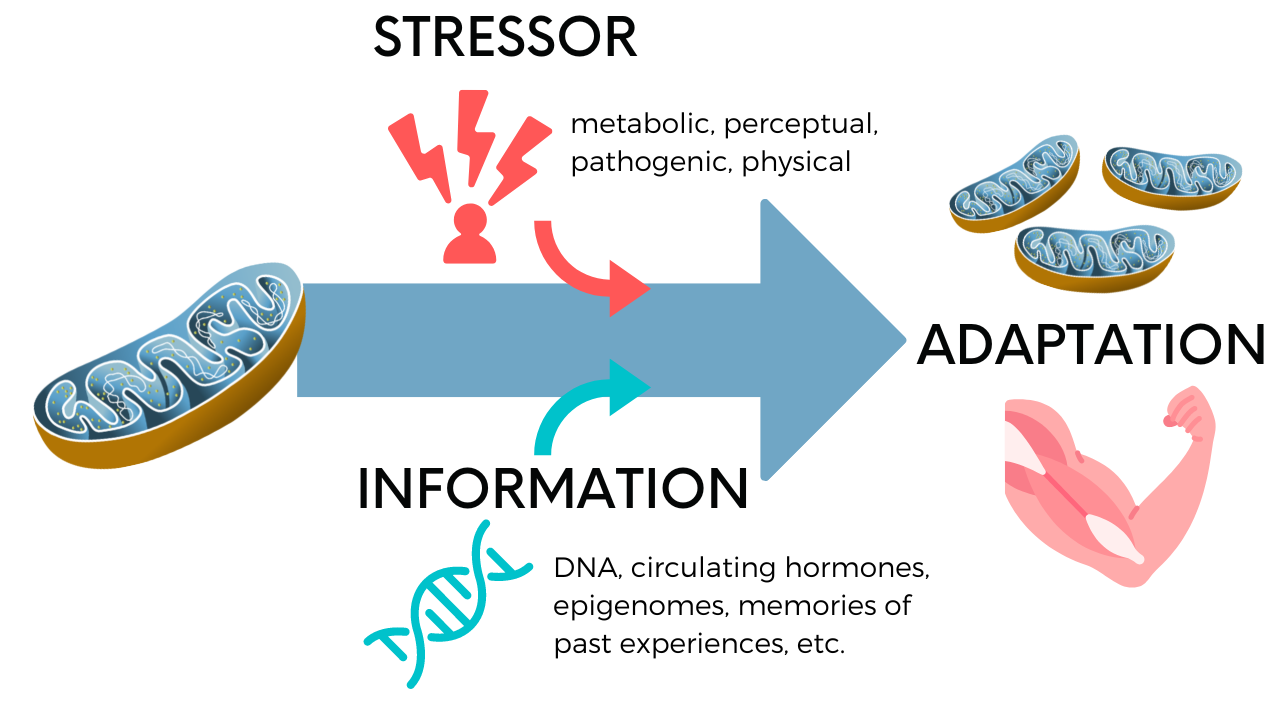
This adaptation can take many forms.
Depending on the type and duration of stress that you put your body under, these adaptations can range from highly positive changes that lead to more efficient, high-energy metabolism that drives important functions like muscular strength, immunity and cognition…
Or, in the face of chronic stress beyond the limit of what your body can handle, you can end up going the opposite direction.
Over time, too much stress leads down the path of metabolic and mitochondrial dysfunction, loss of strength and muscle, increased inflammation, and a higher risk of a range of common diseases.
That’s why your ability to build a super-powered mitochondrial machine is the single best way to not just improve all areas of physical and mental performance, but to shield yourself against the stress of life.
So, with all that said, let’s talk about how to make sure you’re building that machine.
Why metabolic training is the key to increasing your mitochondria quantity and quality
Over the last 20 years, both the research and my own personal experience in fitness has consistently shown that metabolic conditioning is the single most powerful and important tool we have to build our mitochondrial machine to drive a longer, healthier life and better performance.
That’s because this type of training puts our cells under a high level of metabolic stress by dramatically increasing the amount our energy our cells need to workout.
In turn, this stress triggers the signaling pathways that lead to changes in your gene expression that drive improved metabolic efficiency and energy-producing capacity.
Not surprisingly, mitochondria are at the heart of these changes in multiple ways.
While most people know that metabolic training increases the number of mitochondria you have in your cells, what’s much less discussed is that it also increases their quality.
This is happens through complex processes collectively known as Mitochondrial Quality Control (MQC) that include changes like:
- Increased fusion to create a vast network of elongated mitochondria that span your muscle fibers (see image below)
- Activation of sirtuin enzymes that regulate genes that drive improved efficiency in the electron transport chain (ETC) where most of your ATP is made
- Increased mitophagy (breakdown and recycling) of poorly functioning mitochondria
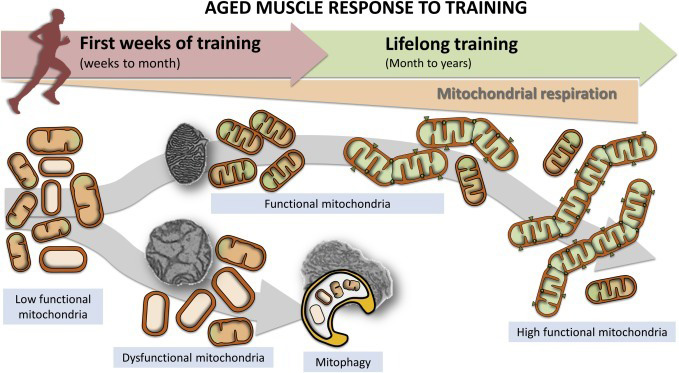
Image Source: Rafael A. Casuso, Jesús R. Huertas, The emerging role of skeletal muscle mitochondrial dynamics in exercise and ageing, Ageing Research Reviews, Volume 58, 2020, 101025, ISSN 1568-1637
All of these changes leave you with a much better, higher-performing mitochondrial machine. One that is able to use less oxygen to produce the same amount of energy.
This also means that it has the ability to really crank up energy production to even higher levels when you need it. You can think of this ability as metabolic reserve and this is hugely valuable no matter what your fitness goal may be.
You also end up with better insulin sensitivity, increased fat oxidation, reduced levels of inflammation, decreases in DNA damage (both in the nucleus and the mitochondria), and a whole host of other longevity and performance-enhancing benefits.
But here’s the key: all of these hugely important changes only happen when you get the dose of metabolic stress right.
The same metabolic stress that can be so powerful for building super mitochondria can also turn things the other way and cause mitochondrial dysfunction when you get it wrong.
A recent paper looked at how this can happen when you crank up the dose of high-intensity metabolic training beyond what your body can recover from.
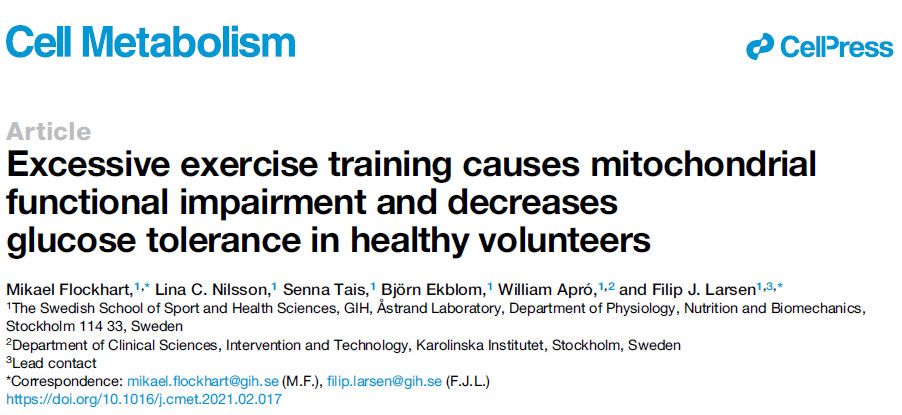
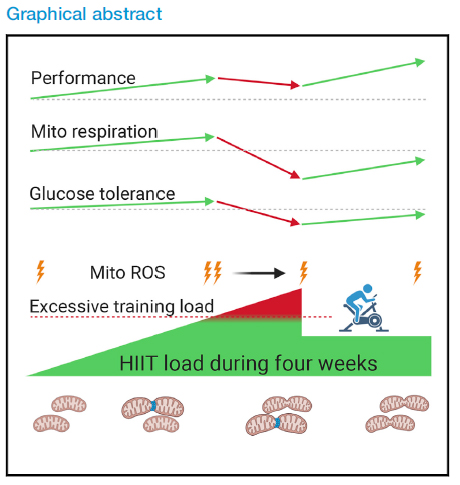
Over the first 3 weeks of the study, researchers ramped up the amount of high intensity training while they simultaneously measured a wide variety of markers of mitochondrial and overall metabolic function.
During the 4th week, they dramatically reduced the volume to allow for recovery.
As the graphic clearly shows, more high intensity metabolic training is definitely not always better. There is an upper limit to how much your body needs, and exceeding that limit has consequences for your mitochondria and your metabolism as a whole.
That’s why getting the overall right amount of metabolic training, i.e. the volume, as well as the distribution of intensity, is absolutely critical when it comes to building your mitochondria and metabolic performance.
The value of zone-based heart rate training
The easiest way to strike the right balance between volume, intensity, and recovery is to use a heart rate monitor during all your metabolic training.
People have been using heart rate zones to guide various forms of steady state metabolic training since the early 1980’s. This is particularly true in the endurance world.
In the last couple of years, there’s been an uptick in the discussions around “zone 2 training”—an important topic that I’ve been writing about extensively for almost 15 years.
This is good news, because metabolic training is about much more than just doing high intensity intervals over and over again.
What’s missing, however, is that while people generally understand that each of us have a different “zone 2” based on our own genetics, metabolism, and fitness level, that hasn’t translated into the way people typically do higher intensity training.
That’s a problem because training of all types, not just steady state work, needs to be built around your own genetics, metabolism, fitness level, and recovery.
That’s the biggest reason why I created a framework around Zone-Based Interval Training (ZBIT). I designed the model to give people a more effective, more personalized approach to dialing in the right dose of metabolic training across a range of intensities.
As a starting point, I created 12 different ZBIT methods, ranging from low intensity all the way up to the max heart rate.
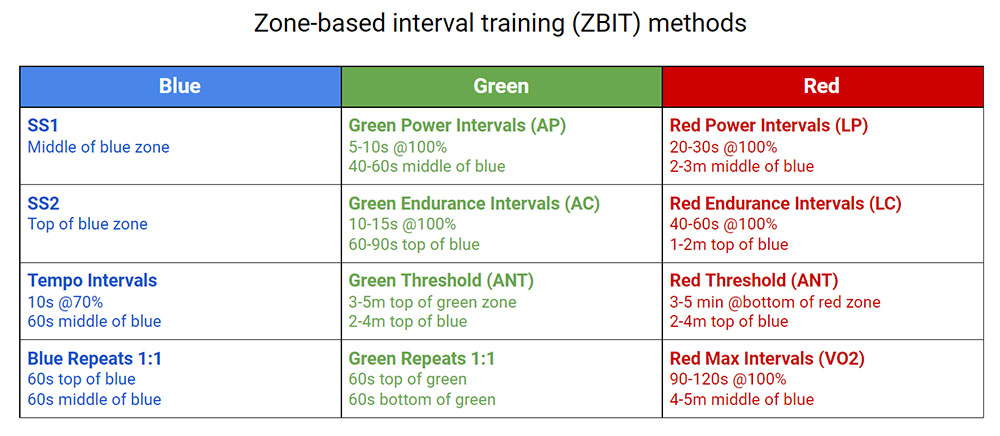
The three heart rate zones are based on my Morpheus Training system (click here to learn more).
We’re also about to launch a brand new Morpheus Training feature specifically designed around the 12 ZBIT methods (see the video below), but you can also apply the same concept and guidelines if you’re using another zone model.
Why do you need to do more than just high intensity?
Well, aside from the study I cited earlier, there are many reasons why it’s important to incorporate a wide range of intensities and volumes across all heart rate zones. One of the biggest is that to build an efficient metabolic engine and drive both performance and longevity, you need to develop the mitochondria within all your cells and tissues.
When you’re doing lower intensities, you’re primarily targeting mitochondria in your slow-twitch muscle fibers and supporting tissues. As you crank up the intensity and start recruiting more and more muscle fibers, you’re also putting more mitochondria under the metabolic stress they need to adapt and improve.
And aside from the muscles that are directly working while you train, the mitochondria in your brain, heart, lungs, etc. are all working hard during metabolic training. Because they also have different capacities and are built specifically for the type of cells they are in, they respond to varying volumes and intensities.
It’s valuable to consider that a big part of what makes metabolic training so powerful is that it has the potential to positively impact so many different cells throughout the body, well beyond the working muscles.
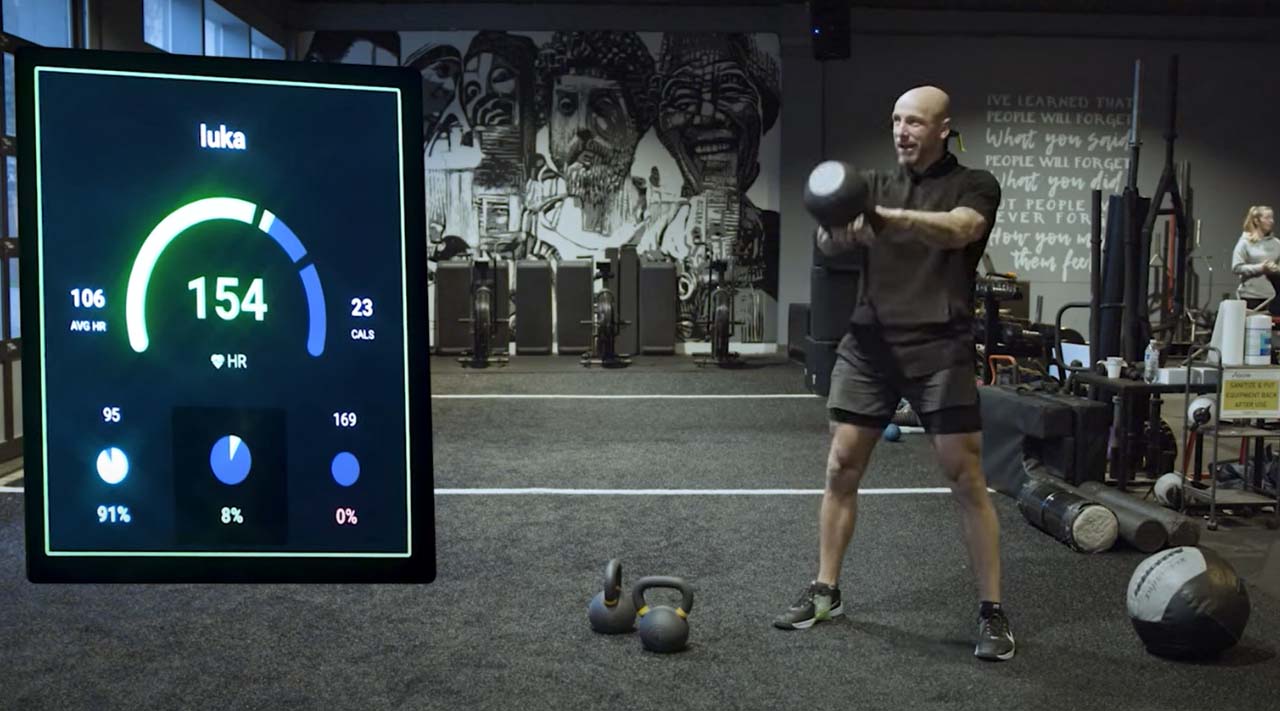
This is a large part of why metabolic training, and exercise in general, has been so closely linked with things like cognitive function, a healthy immune system, disease prevention, and a longer healthspan.
Exactly how much metabolic training volume and intensity you need depends on a huge number of variables, but I can still give you some general guidelines.
After analyzing more than 500,000 workouts and data points from thousands of Morpheus users, we found some common denominators across multiple segments of people with varying fitness levels.
People who saw increases in their heart rate variability and decreases in their resting heart rate across a 12-week period—both positive signs of an improved metabolic engine—consistently fell somewhere within following ranges:
- Blue zone: 200-300 min/wk
- Green zone: 40-50 min/wk
- Red zone: 11-14 min/wk
Another hugely important lesson our data showed is that people whose metrics got worse across a 12-week period spent more of their time at higher intensities than those who improved.
People with moderate fitness levels who saw improvements, for example, spent a little less than 15 minutes per week in the red zone. People whose number declined, on the other hand, spent nearly 20 minutes in the same zone.
Even more, the people with the highest level of fitness to start with spent the fewest number of minutes at the highest intensities—a little more than 11 minutes per week.
Taken together with the paper I mentioned earlier, along with my own findings over 20 years as coach, this reinforces the simple truth that when it comes to high intensity, you only need a little to accomplish a lot—and more is definitely not always better.
If you want to learn more, you can click here check out a replay of a webinar I did a few months back on ZBIT.
Or, if you want to started with Metamorphosis – my complete 8-week conditioning MasterProgram click here to learn how.
Putting the pieces together: How to help your mitochondria help you
I hope that by now, I’ve convinced you that if you’re not already doing some form of metabolic conditioning on a consistent basis, you should be.
If you care about your performance, health and longevity, metabolic conditioning needs to be more than just something you throw onto the end of your strength workout.
Even if your goal is just to build strength and/or power, it should be obvious why that still requires an efficient, high-powered metabolic engine driven by mitochondria.
At the very core of life itself the ability to adapt to our environment and that starts with the magic of mitochondria and everything they do.
As soon as we start to lose our adaptability, everything begins to decline and the aging process accelerates like a freight train. In many ways, aging is nothing more than the gradual loss of adaptability that leads to a progressive loss in our cellular integrity and our ability to truly live.
There’s even research to suggest that one of the core reasons we lose muscle mass and strength and age isn’t just because we didn’t spend enough time in the weight room, but more because as our bodies lose metabolic capacity, it also loses the ability to support muscle mass.
Because muscle is a metabolically expensive tissue to maintain, it makes sense that as metabolic function declines, our body starts to shed muscle mass and strength to compensate.
This doesn’t mean that strength training isn’t important, it certainly is, but it does mean that understanding the bigger picture of biology and what’s happening under the surface is a hugely important key to making the right training and lifestyle decisions.
Too much of the research and advice that’s out there is based on only looking at one very small piece of the puzzle, but we need to know how what all the pieces are and how they fit together.
That’s why I’m just getting started.
Stay tuned for more…

I’m not sure if the Ivan Wallin endosymbiotic hypothesis for the origin of mitochondria is actually true, but it was a great article nonetheless.
I think there’s enough evidence to support the general hypothesis even if all the details aren’t all sorted out or as clear, but glad you enjoyed the article
Hey Joel–great article for me. Have been following you for awhile (like many). You keep getting clearer and clearer. I have taken your first Metabolic course and found tremendous changes, especially in HR Recovery. Towards the end of that 8 weeks I was degrading in performance.
So your simple above training ranges–just helped reinforce what you have said in the past–i guess takes time to sink in though, huh
Well appreciate all that you do and it is a real gift to keep hearing from you.
Best wishes in your deeper dives–Pete
Peter,
Thanks, glad you enjoyed the article and program. I’ve got plenty more in the works!
I’m 60 years old and devoting the minimum combined weekly minutes of 251 to the Blue / Green / Red zones is over 4 hours!!! Then I’ve still got to pump iron for 4 sessions (2 upper body / 2 lower body, each lasting 60 – 75 minutes and that’s over 9 hours a week. Not very practical and physically impossible at this stage of life.
If you’re spending 4+ hours per week lifting weights because you really enjoy it, then more power to you, but nowhere near that amount is required for building enough muscle and strength to improve longevity. Research shows the benefits top out at around 1 hour per week. From a health/longevity standpoint, you’d be much better off shifting how you’re spending your training time towards metabolic work.
I am 63, and upon first viewing the 8Weeks Out program I was sacred- could I really do this at my age? Level 2 just seemed like an impossibility. I have done 12 weeks of level 1 and now 10 weeks of level 2 so a total of 22 weeks with a 1 week rest period between levels. The metabolic effects started to really kick in around 10 weeks. Now are substantial. RHR is now 48 on rest days, 53 after a training day. My pushups went from 50 to now 100 straight through. Pullups now 25 lb weighted at 3 sets of 12. I find these numbers extraordinary for someone my age. Note to EverClever, it is all about priorities.
David,
Those are really amazing results. Doing weighted pull ups for 3×12 on top of a low RHR at 63 is really impressive. Great work!
Hi Joel,
What is your opinion on testing lactate levels and setting individual training zones?
Thanks.
I think it can be done, but it’s generally very impractical to be measuring blood-lactate levels throughout a testing and those numbers will then only be accurate for that particular exercise. For someone that’s a runner or cyclist or athlete in a single movement sport like that, then it can be effective, but for most peopl, it’s just not practical.